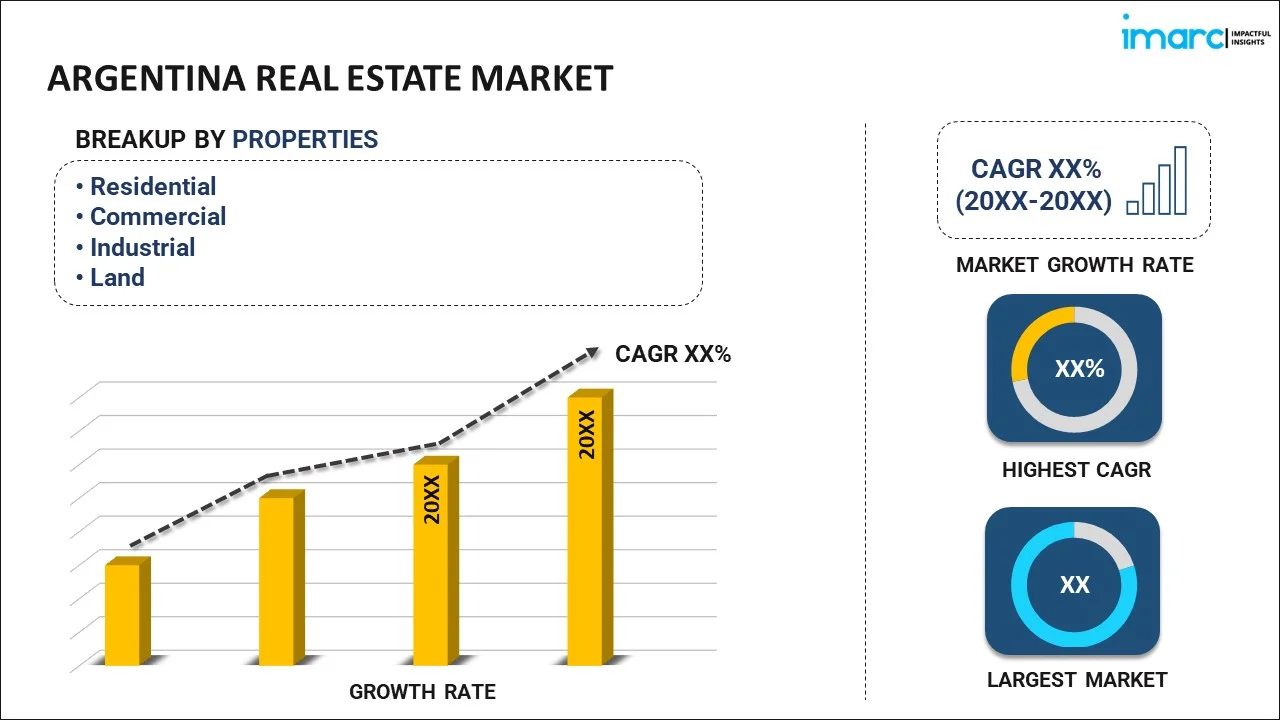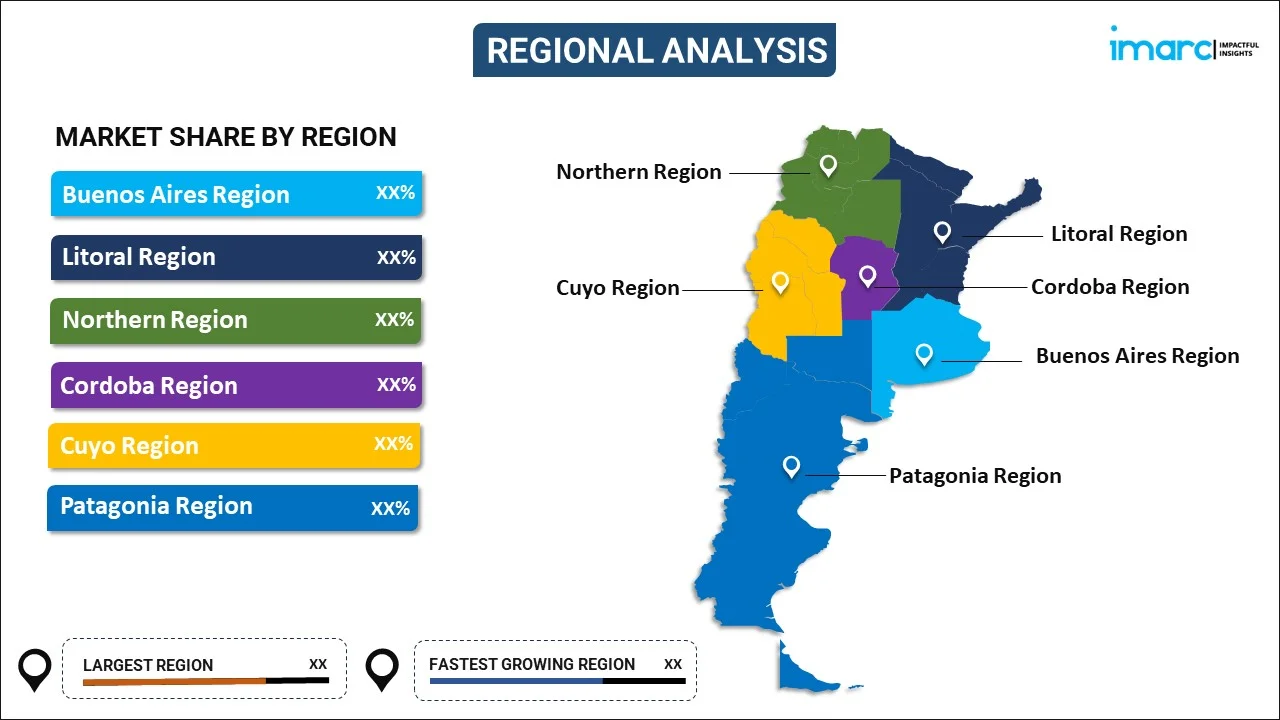
Argentina Real Estate Market Report by Property (Residential, Commercial, Industrial, Land), Business (Sales, Rental), Mode (Online, Offline), and Region 2025-2033
Argentina Real Estate Market:
The Argentina real estate market size is projected to exhibit a growth rate (CAGR) of 3.04% during 2025-2033. Economic stability and the higher demand for residential spaces are stimulating the market.
|
Report Attribute
|
Key Statistics
|
|---|---|
|
Base Year
|
2024 |
|
Forecast Years
|
2025-2033 |
|
Historical Years
|
2019-2024
|
| Market Growth Rate (2025-2033) | 3.04% |
Argentina Real Estate Market Analysis:
- Major Market Drivers: Government incentives encourage new construction projects, thereby enhancing the availability of modern properties and attracting investors looking for profitable opportunities.
- Key Market Trends: Rising urbanization trends in major cities and the inflating need for housing, commercial establishments, and infrastructure are accelerating the market growth.
- Competitive Landscape: The report has provided a comprehensive analysis of the competitive landscape in the market. Also, detailed profiles of all major companies have been provided.
- Geographical Trends: The urban center sees robust investment due to high demand, while the Litoral Region benefits from commercial expansion. In contrast, the Northern Region attracts interest for its growth potential, Cordoba offers educational and business opportunities, and Patagonia appeals for its natural allure and development potential.
- Challenges and Opportunities: The economic instability and regulatory hurdles are hampering the market. However, implementing stable policies and creating favorable investment conditions to attract both local and international investors will continue to bolster the market over the forecasted period.
Argentina Real Estate Market Trends:
Increased Financing Options Stimulate Property Demand
The expanding mortgage availability makes home buying more accessible, thereby leading to higher demand for properties. When more people can secure loans, the real estate market experiences increased activity and rising property values, reflecting greater overall market engagement. For example, in May 2024, government bodies in Argentina reintroduced mortgage loans with 13 banks. This has led to more homebuyer interest and a slight rise in property values in Buenos Aires, thereby boosting activity in the housing market.
High-profile Projects Attract Investor Interest
Large and prominent real estate projects, such as those featuring unique amenities or significant scale, draw considerable attention from investors. These developments often signal market potential and can increase investment, thereby enhancing overall market vibrancy and contributing to the Argentina real estate market share. For instance, in May 2024, the launch of RIA in Distrito Cero, Rosario, highlights a major advancement in Argentina's real estate market. This 111-acre project by Crystal Lagoons features a stunning turquoise lagoon and premium residential options, reinforcing the company's growing impact across the country, including recent successes in Buenos Aires and Mar del Plata.
Strategic Partnerships Expand Market Reach and Visibility
Forming strategic partnerships with well-known entities or organizations helps real estate companies to increase their market presence and brand visibility. Such collaborations can attract new clients and investors, broadening market influence and boosting opportunities for growth in various regions. For example, in September 2024, Prestige One Developments secured a landmark sponsorship with the Argentine Football Association as the first regional real estate partner in the Middle East. This deal, featuring joint marketing campaigns and player endorsements, boosts Prestige One's visibility and drives market growth by expanding its influence and attracting new clients across the region.
Argentina Real Estate Industry Segmentation:
IMARC Group provides an analysis of the key trends in each segment of the market, along with the Argentina real estate market forecast at the country and regional levels for 2025-2033. Our report has categorized the market based on property, business, and mode.
Breakup by Property:

- Residential
- Commercial
- Industrial
- Land
The report has provided a detailed breakup and analysis of the market based on the property. This includes residential, commercial, industrial, and land.
Residential properties are increasingly sought after, reflecting rising Argentina real estate market demand. Commercial spaces are expanding with new developments, industrial investments are growing, and land acquisitions offer promising opportunities for future growth and development.
Breakup by Business:
- Sales
- Rental
The report has provided a detailed breakup and analysis of the market based on the business. This includes sales and rental.
In Argentina, real estate activity includes both sales and rentals. The sales market sees the rising demand for properties due to increased financing options, while the rental sector remains strong, driven by urban growth and shifting lifestyle preferences.
Breakup by Mode:
- Online
- Offline
The report has provided a detailed breakup and analysis of the market based on the mode. This includes online and offline.
In Argentina, the real estate market operates through both online and offline channels. Online platforms enhance property visibility and facilitate transactions, while offline methods, such as traditional agencies and property viewings, continue to play a crucial role. According to the Argentina real estate market analysis report, this will continue to fuel the growth of the segment in the coming years.
Breakup by Region:

- Buenos Aires Region
- Litoral Region
- Northern Region
- Cordoba Region
- Cuyo Region
- Patagonia Region
The report has also provided a comprehensive analysis of all the major regional markets, which include the Buenos Aires Region, Litoral Region, Northern Region, Cordoba Region, Cuyo Region, and Patagonia Region.
According to the Argentina real estate market outlook, this industry shows varied dynamics across regions. The Buenos Aires Region is known for its vibrant residential and commercial activity. In addition to this, the Litoral Region thrives due to its agricultural and logistical importance, and the Northern Region sees growth from infrastructure projects and regional development. Moreover, the Cordoba Region benefits from its role as an educational and business hub. In line with this, the Cuyo Region, famous for its vineyards, attracts lifestyle buyers. At the same time, the Patagonia Region offers stunning natural landscapes appealing to those seeking recreational and eco-friendly investments.
Competitive Landscape:
The Argentina real estate market research report has also provided a comprehensive analysis of the competitive landscape in the market. Competitive analysis, such as market structure, key player positioning, top winning strategies, competitive dashboard, and company evaluation quadrant, has been covered in the report. Also, detailed profiles of all major companies have been provided.
Argentina Real Estate Market Recent Developments:
- September 2024: Prestige One Developments secured a landmark sponsorship with the Argentine Football Association as the first regional real estate partner in the Middle East. This deal, featuring joint marketing campaigns and player endorsements, boosts Prestige One's visibility and drives market growth.
- July 2024: Justoken expanded its presence in Brazil and Argentina, catering to various industries for both real and digital assets.
- May 2024: Crystal Lagoons introduced RIA in Distrito Cero, Rosario, that features a stunning turquoise lagoon and premium residential options, thereby reinforcing the company's growing impact across the country, including recent successes in Buenos Aires and Mar del Plata.
Argentina Real Estate Market Report:
| Report Features | Details |
|---|---|
| Base Year of the Analysis | 2024 |
| Historical Period | 2019-2024 |
| Forecast Period | 2025-2033 |
| Units | Billion USD |
| Scope of the Report | Exploration of Historical Trends and Market Outlook, Industry Catalysts and Challenges, Segment-Wise Historical and Predictive Market Assessment:
|
| Properties Covered | Residential, Commercial, Industrial, Land |
| Businesses Covered | Sales, Rental |
| Modes Covered | Online, Offline |
| Regions Covered | Buenos Aires Region, Litoral Region, Northern Region, Cordoba Region, Cuyo Region, Patagonia Region |
| Customization Scope | 10% Free Customization |
| Post-Sale Analyst Support | 10-12 Weeks |
| Delivery Format | PDF and Excel through Email (We can also provide the editable version of the report in PPT/Word format on special request) |
Key Questions Answered in This Report:
- How has the Argentina real estate market performed so far, and how will it perform in the coming years?
- What has been the impact of COVID-19 on the Argentina real estate market growth?
- What is the breakup of the Argentina real estate market on the basis of property?
- What is the breakup of the Argentina real estate market on the basis of business?
- What is the breakup of the Argentina real estate market on the basis of mode?
- What are the various stages in the value chain of the Argentina real estate market?
- What are the key driving factors and challenges in the Argentina real estate?
- What is the structure of the Argentina real estate market, and who are the key players?
- What is the degree of competition in Argentina real estate market?
Key Benefits for Stakeholders:
- IMARC's industry report offers a comprehensive quantitative analysis of various market segments, historical and current market trends, market forecasts, and dynamics of the Argentina real estate market from 2019-2033.
- The research report provides the latest information on the market drivers, challenges, and opportunities in the Argentina real estate market.
- The study maps the leading, as well as the fastest-growing, regional markets.
- Porter's five forces analysis assists stakeholders in assessing the impact of new entrants, competitive rivalry, supplier power, buyer power, and the threat of substitution. It helps stakeholders to analyze the level of competition within the Argentina real estate industry and its attractiveness.
- The competitive landscape allows stakeholders to understand their competitive environment and provides insight into the current positions of key players in the market.
Need more help?
- Speak to our experienced analysts for insights on the current market scenarios.
- Include additional segments and countries to customize the report as per your requirement.
- Gain an unparalleled competitive advantage in your domain by understanding how to utilize the report and positively impacting your operations and revenue.
- For further assistance, please connect with our analysts.
 Inquire Before Buying
Inquire Before Buying
 Speak to an Analyst
Speak to an Analyst
 Request Brochure
Request Brochure
 Request Customization
Request Customization




.webp)




.webp)












